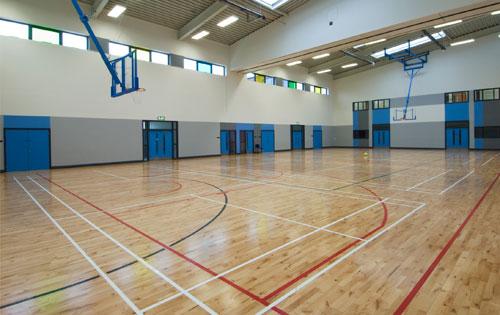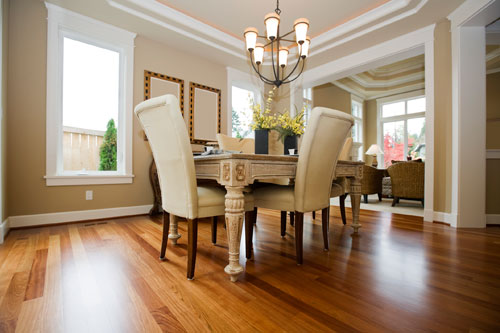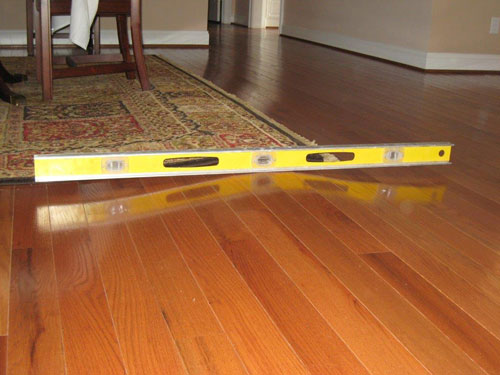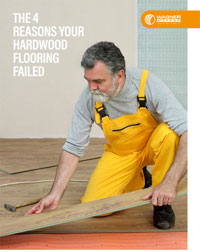How Much Money Is Wasted Due to Flooring Problems Every Year?
Flooring is more than just the surface you walk on—it’s the foundation of a building’s durability, functionality, and aesthetics. Yet, moisture-related flooring failures continue to cost contractors, businesses, and homeowners a staggering $2.4 billion per year in remediation and repairs.

For general contractors and flooring installers, these failures don’t just mean wasted materials and labor costs—they can also lead to delays, reputation damage, and financial losses. For building owners, failed floors can mean disruptions, costly repairs, and even health risks from mold and mildew.
So what’s the biggest culprit behind these flooring failures? Moisture.
In this article, we’ll cover:
✔️ The real cost of moisture-related flooring failures
✔️ Why concrete and wood floors fail—and how moisture plays a role
✔️ The key steps to preventing expensive flooring problems
✔️ Why proper moisture testing is the smartest investment you can make
By understanding where moisture issues come from and how to test for them, contractors and building owners alike can avoid costly repairs, protect their investment, and ensure long-lasting, durable floors. Let’s dive in.
Much of the integrity of a house or industrial building comes from its flooring. It’s the structural base for the whole project, and it controls the overall mechanics of each room. It affects the noise levels and has everything to do with the aesthetics and culture of the building.
Bottom line, the right flooring makes or breaks the project.
Yet there’s still an alarming amount of money that is wasted every year because of flooring issues.
“Moisture control is often one of the most crucial, yet most overlooked, elements of any floor’s success over time.”
This enormous waste of money affects everyone involved. General contractors, flooring contractors, and especially the owners of the building, be they corporations, small businesses, or even homeowners.
No one can escape the troubles of flooring failures.
- Contractors lose business and their reputations are at risk.
- Businesses postpone building and opening schedules.
- Homeowners forfeit the home of their dreams and have to rearrange their everyday living around extensive repairs.
And each of them is losing money. As an industry, flooring is losing billions in the remediation of concrete slab and floor coverings, which is all as a result of moisture-related flooring failures. Collectively, the industry loses $2.4 billion—annually.
After all the time and effort that goes into constructing a business or a home, the last thing contractors and owners should deal with is flooring failures. And to avoid flooring problems, everyone involved needs to know the components of a floor, the potential issues, and how to prevent those issues from ever coming to fruition.
What Causes Flooring Failures? Concrete vs. Wood

Of all the places to skimp and save money on a building, flooring is not one of them. Due to the high volume of foot traffic buildings and homes typically have, extra measures and precautions need to be implemented to create a floor that can withstand time and constant traffic.
The finished flooring we see is just a covering, meant to be the beautiful part of this structural design. Though this part is mainly just for show, it takes the brunt of the foot traffic and needs the support of joists and a subfloor.
Below the floor coverings, all floors should have the subfloor and underlayment.
The subfloor is the flooring foundation, and—if installed properly—it can last a lifetime. However, if not, there are high price tags on the costs to replace subfloors.
There are two main categories all subfloors fall into: concrete or wood. And water affects both in many ways.
One important element of flooring to understand is this: Moisture evaporation is natural.
It’s a part of nature and, therefore, part of the lifecycle of buildings and homes. However, that doesn’t mean it has to ruin projects.
“The #1 cause of flooring failures is moisture.”
If moisture is both natural and our worst enemy, what can we do?
First, learn where this water is coming from.
In some water situations, we have zero control—as in a natural disaster. However, moisture that comes from soil, concrete, cleaning and maintenance, and ambient conditions, we can either prepare and prevent or test and repair.
Excess water creates bubbles, issues with adhesive, warping, and gaps, and these reactions to imbalanced moisture content extend beyond the floor to the whole infrastructure.
Concrete Subfloor Moisture Issues
 Concrete harbors water vapor that fluctuates.
Concrete harbors water vapor that fluctuates.
For a concrete slab on grade, groundwater greatly influences the water vapor in the slab, which is why it is a common practice to place a vapor retarder under the slab. These vapor retarders prevent much of the moisture of the soil from entering the slab.
With the vapor retarders in place, contractors turn their attention to the necessary evaporation of the “water of convenience.”
When laying the concrete, the excess water—the water of convenience—has to evaporate through the surface. This process can take a long time, and depending on the humidity levels surrounding the slab, the concrete can either lose water vapor or gain more during the process.
This process, the proper curing and drying of the slab, is crucial to avoiding flooring problems.
“‘Curing’ is the chemical reaction that creates the agglomerate better known as concrete, while ‘drying’ is the loss of water not needed to hydrate the cement.”
When vapor retarders are properly installed and the concrete has time to cure and dry, the concrete is less likely to take in the moisture that naturally seeps up from the ground below. The less moisture in the slab, the less likely it is that the adhesives will break down, therefore preventing major flooring problems.
What can go wrong with floors installed on concrete?
- Debonding: When adhesive breakdown occurs, glues become fluids that start to leak instead of stick and also may produce less-than-desired odors.
- Bubbles: When water and air gets trapped between the concrete and the coating, small imperfections—bubbles—form on the surface of the coating.
- Blisters: Blister imperfections in the finish are most commonly found when water from the concrete seeps up into the semi-permeable seal or coating.
Why do these issues occur?
Not all concrete drying times are created equal. Meaning just because last month’s slab dried at X rate, doesn’t mean this week’s slab will be as cooperative.
Not all adhesives are created equal, and they aren’t supposed to be. For the many types of floor coverings, there are many kinds of adhesives. The problems are when the floor covering is installed with the wrong adhesive or when the application and installation is done incorrectly. Both can lead to adhesive failure.
Not all products are created equal. Flooring products vary in their tolerance to relative humidity (RH) percentages. For contractors to know these differences means they can plan accordingly and reduce the risk of flooring failure costs.
Not all installers are created equal, so to get the best for your buck, do the research, find a credible, recommended, and trusted flooring contractor who can get the results you need without going over budget.

Wood Flooring Issues
As mentioned above, vapor barriers are the hero of concrete slabs, and the same goes for wood flooring. Without retarders, it’s only a matter of time before moisture damages floor coverings.
Hardwood flooring warps, water stains can ruin engineered wood, and vinyl may form ruts. And what about carpet? Ever heard of mold? Or better yet, ever smelled it? No floor covering is immune to water damage.
However, floor coverings aren’t the worst problem. When the subfloor is compromised due to moisture issues, that’s when the real damage is done, and the cost to replace a subfloor is no small number.
What can go wrong with wood flooring?
- Floor cupping: This happens when each panel becomes concave where the sides are higher than the center.
- Gaps: For hardwood floors, laminate, and others, gaps occur between the boards when panels shift due to swelling and contracting when panels gain and lose excess moisture.
- Buckling: Though uncommon, buckling is when the wood flooring completely detaches from the subfloor below.
- Pests and mold: Damp environments are the perfect place for termites and ants to set up camp and for mold to grow. And no one wants that in their subfloors.
Why do these issues occur?
Hardwood flooring is placed where it shouldn’t be. For rooms that inherently have more moisture content—laundry rooms, bathrooms, and kitchens—hardwood flooring is not recommended.
Ambient conditions are not favorable to wood flooring. For buildings in high humidity areas, such as near oceans or other bodies of water, it’s important to do the research for appropriate flooring.
Subfloors weren’t properly cared for during construction. Due to ever-tightening building schedules, sometimes the most important parts can be overlooked, like neglecting to allow subfloors and joists to completely dry before applying coverings and sealing the moisture in.
Costs of Repair
The monetary expenses of repairing flooring problems are usually the main discussion when it comes to the costs. But there are other costs—some just as damaging as flooring repair costs—that contribute to the monetary losses.
Schedules get interrupted, rearranged, and postponed. For business, delays in opening are directly connected to monetary losses. If homeowners are kept out of their houses longer, they’re forced to pay for additional living expenses.
These fast production schedules may not always leave ample time for moisture content to dissipate naturally.

Free Download – 4 Reasons Your Hardwood Flooring Failed
Reputations are tainted, and once the word-of-mouth reputation is compromised, it’s difficult to rebuild. The loss of an excellent reputation means the potential loss of returning and future business.
Not only will companies suffer the drop in sales as a result, but the expenses to repair the reputation—ads and marketing—are pricey.
Health risks of flooring failures disrupt a persons’ well being and create added financial stress of potential medical bills. Studies have shown that damp indoor environments lead to an increase in health problems such as:
- Upper respiratory (nasal and throat) symptoms
- Coughing
- Wheezing
- Asthma symptoms in sensitized persons with asthma
Financial losses are the losses directly related to flooring failure costs. Whether repairing or replacing flooring, both are a big headache that could’ve been avoided had contractors put more time and money into the process from the beginning.
Remember, these flooring problems are costing the industry $2.4 billion on remediation of concrete slab and floor coverings as a result of moisture-related flooring failures.
The floor repair estimate from remediations ranges from as little as $200 to $20,000 or more. If you catch the problem early, you may only have to replace a few tiles or boards, costing a couple hundred.
However, if excess moisture results in molding or rotting floors, you’re automatically at the upper end of the range. To get to the root problem in the joists, underlayment, or subfloors, you have to cover the costs to rip out the floor coverings and the materials to replace them.
Replacing a subfloor is likely not the glamorous DIY project you envisioned, but it’s nonetheless important.
The average cost for repairing 300 square feet of a subfloor is either roughly $438 for materials if you do it yourself or $658 to pay a professional.

But what also should be taken into consideration while the floor is uprooted is identifying and fixing the core issue. Replacing the subfloor/floor coverings without addressing the real problem is like putting duct tape over a crack in the ceiling. It’ll hold for a bit longer, but soon that ceiling is going to cave.
It’s the same with flooring.
So, How Can We Prevent These Expensive Flooring Failures?
Test, test, test.
And since the general contractor and flooring contract are invested in the results and have the potential for bias, it’s best practice to bring in a third-party testing company. Particularly one who doesn’t have anything to gain from false test results.
By testing the flooring, gone is the headache of reparations and the money needed to pay for repairs can stay in your pockets.
Safeguard your concrete and wood flooring with trusted testing done by the Rapid RH® concrete moisture testing system and Orion® moisture meters.
Jason has 20+ years’ experience in sales and sales management in a spectrum of industries and has successfully launched a variety of products to the market, including the original Rapid RH® concrete moisture tests. He currently works with Wagner Meters as our Rapid RH® product sales manager.
Last updated on February 26th, 2025



